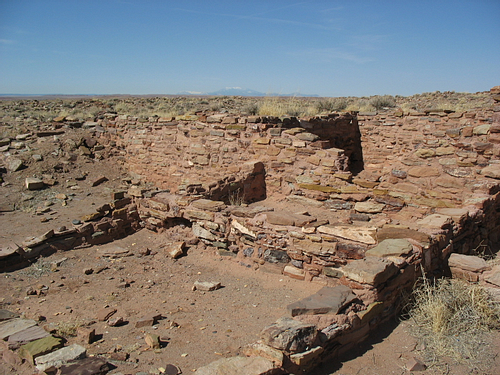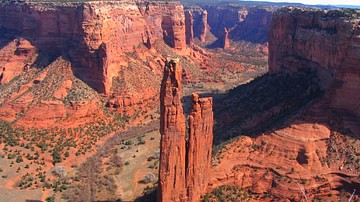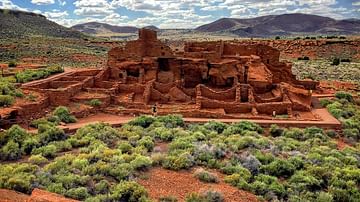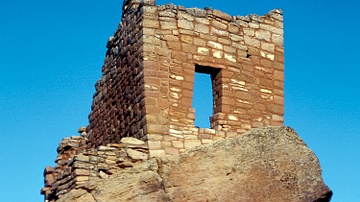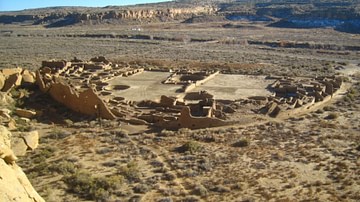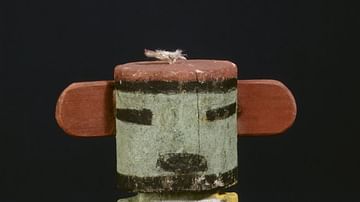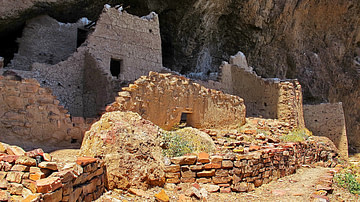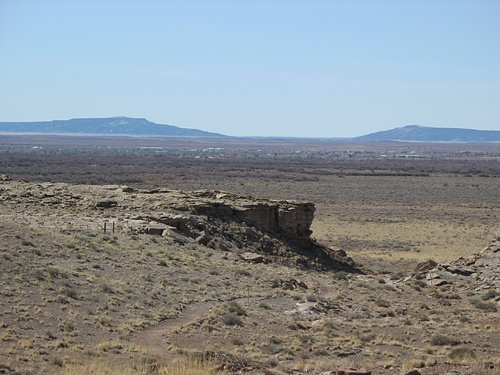
Homolovi or Homolovi State Park (formerly: Homolovi Ruins State Park) is a cluster of archaeological sites that contains the ruins of eight pre-Columbian Ancestral Puebloan (Anasazi) and Hopi pueblos in addition to some 300 other remains and petroglyphs. Homolovi lies within sight of the Little Colorado River in a floodplain, 2 km (4 miles) northeast of Winslow, Arizona in the United States. Archaeologists believe that Ancestral Puebloan peoples and the ancestors of the Hopi tribe once occupied these settlements, which spread out along a 32 km (19 miles) corridor on the Little Colorado River, at different intervals of time from c. 1250-1425 CE. Two pueblos - Homolovi I and Homolovi II - each contained more than 1,000 rooms in ancient times, and 40 ceremonial kivas are scattered throughout the park. The Homolovi ruins are unique in the ancient Southwest as they have helped archaeologists better understand the cultural transitions and social changes that occurred in the region during the 13th through 14th centuries CE. Four of the sites at Homolovi are listed on the U.S. National Register of Historic Places, and the park is currently managed by the Arizona State Park system.
Geography & Prehistory
Homolovi or Homol'ovi is Hopi for “place of the little hills,” and Arizona's Hopi Reservation and Hopi Mesas are located only 84 km (52 miles) north of Homolovi. Lying in extreme close proximity to the Little Colorado River (Hopi: Paayu), Homolovi is situated in the Great Basin Area Desert Grasslands and is 130 km (80 miles) southeast of Flagstaff, Arizona, 117 km (73 miles) from Wupatki Pueblo, and 217 km (135 miles) west of Gallup, New Mexico. Homolovi covers a total area of 1,800 ha (4,500 acres) and sits at a high desert altitude of 1494 m (4,900 ft). Homolovi only receives about 178 mm (7 in) of precipitation annually.
Scientific and archaeological research has shown that nomadic, prehistoric peoples occupied the area that now comprises Homolovi intermittently from c. 4000 BCE- 400 CE. The Little Colorado River made the area somewhat attractive to an array of fauna: cottontail rabbits, jackrabbits, beavers, prairie dogs, porcupines, waterfowl, fish, elk, deer, and antelope come to the river seasonally. Ancient prehistoric peoples and tribes came occasionally to the region while hunting and migrating seasonally, but they did not construct settlements within the region until c. 500-600 CE. The reasons for this are likely due to the area's very dry climate and lack of wood and storable food resources. When possible and climatic conditions were favorable, early sedentary people hunted and gathered like their prehistoric forebears, but they also began farming, growing corn, beans, squash, and other small crops. It is also known that they grew cotton for textile production. Yucca and rice grass have grown in the area for several millennia, and indigenous people utilized rice grass as a staple food when the maize crop failed.
There were two periods of inhabitation of Homolovi prior to the construction of the pueblos at Homolovi in the 13th and 14th centuries CE: an Early Period from c. 600-900 CE and Middle Period from 1000-1225 CE. When favorable climatic conditions existed in the 11th and 12th centuries CE, indigenous peoples built small pit houses as opposed to large-scale constructions made of adobe. These earlier occupations of the area around Homolovi appear short-lived and sporadic, lasting around a decade or two. This pattern of periodic settlement and abandonment is likely due to changing local environmental conditions and the Little Colorado River. Depending on the year, the river could be bone-dry due to lack of rain or prone to flooding due to heavy snowfalls near the river's headwaters. It is known that the Little Colorado River was flooded regularly in the early 1200s CE and that the decades leading up to the 13th century CE were wet.
Ancestral Puebloans & Hopi
It is clear from archaeological excavations that there is no overlap in terms of ceramics or stratigraphy between these periods and the period in which the Ancestral Puebloans dwelt at Homolovi. Homolovi had no human population by the middle of the 1200s CE, and the newcomers who entered Homolovi at the end of the 13th century CE were migrants from what is now the Hopi Mesas in Arizona. These newcomers settled the Homolovi's floodplain on the Little Colorado River, eking a living based on farming. It is not exactly known why they came to farm and settle at Homolovi, but it is probable that they did so because of a population influx at the Hopi Mesas, as a result of human migration stemming from the collapse of larger Ancestral Puebloan settlements like Wupatki, Hovenweep, and Mesa Verde. Some anthropologists and archaeologists have suggested that the settlements at Homolovi were of high strategic value to the Ancestral Puebloans of the Hopi Mesas, hence their subsequent settlement and development.
Because Homolovi lay at a crossroads of cultural exchange between the Ancestral Puebloans, the Mogollon culture, and the Hohokam culture, trade stimulated community growth and brought wealth to Homolovi. The remains of ceramics, obsidian, and shells at Homolovi demonstrate that the ancient pueblos traded with members of the Sinagua culture, the Hohokam culture, and other Ancestral Puebloan peoples. Homolovi's indigenous population cultivated cotton, which enriched the pueblos as this crop was grown primarily for the purposes of trade with surrounding communities. Beginning in c. 1300-1350 CE, the Ancestral Puebloans began to build pueblos, supporting a population numbering about 2,500 people by the late 1300s CE. Today, visitors to Homolovi can visit Homolovi Pueblos I and II. The latter had over 1,200 rooms, making it the largest of the Homolovi pueblos.
Excavations at Homolovi have shown that the Ancestral Puebloans hunted and perhaps sacrificed certain animals for ceremonial usage and that their placement in ritual spaces created a robust archaeological pattern. (Many of these ceremonial remains included raptors, turkeys, and rabbits.) Archaeologists believe that changes in ritual animal use over time reflect the rise of the katsina religion with its usage of kachinas (spirit beings) around c. 1350 CE. As the katsina religion took hold, the Ancestral Puebloans at Homolovi's pueblos filled former ritual spaces like kivas and their square plazas.
Abandonment & Current Preservation
Although settlement at Homolovi occurred during an era of considerable upheaval and migration in the ancient Southwest, there is a paucity of evidence for open conflict and social chaos at Homolovi as well as the region near the ruins. The relationship between the various pueblos at Homolovi appear to be peaceful, and unlike at other Ancestral Puebloan sites, archaeologists have not found burned remains, desecrated skeletal remains, but instead open plazas and accessible pueblos. This has led some scholars to theorize that Homolovi's settlement and subsequent abandonment had more to do with climatic change, economics, and new social habits. Homolovi's inhabitants appear to have quietly left their pueblos sometime around c. 1400 CE and returned to the communities at the Hopi Mesas. The Hopi never forgot their ties to Homolovi and they occasionally made pilgrimages to perform rituals near the abandoned pueblos. Homolovi and its environs would not be inhabited again until 1876 CE when a group of Latter-day Saints led by Lot Smith tried to farm the land. This venture failed due to a mixture of extreme climatic conditions involving drought and flooding, and the Mormon settlers left the area in 1888 CE.
Archaeologists began studying and excavating the sites within Homolovi State Park in the 1970s and 1980s CE, and these efforts continue today. It is worth noting that the archaeological excavations at Homolovi lend significant credence to the oral stories and histories of the Hopi tribe with regard to their customs and migrations. The Hopi continue to regard Homolovi as a sacred place, and they continue to make pilgrimages to these sites, renewing the ties between the Hopi people and their land.

